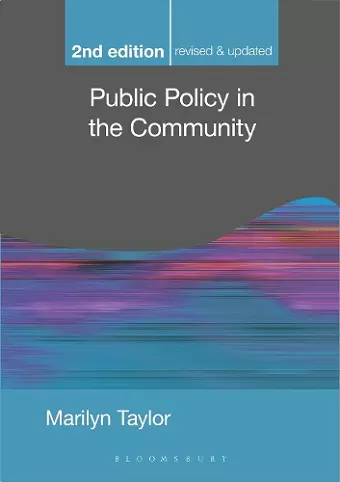Public Policy in the Community
Format:Paperback
Publisher:Bloomsbury Publishing PLC
Published:13th Jul '11
Currently unavailable, and unfortunately no date known when it will be back

Reviews of the first edition: '[A]n excellent overview of how the concept of community has been interpreted and (ab)used by politicians and policymakers...The book takes familiar concepts and methods, weaving them together to build a new framework [and] throws up a number of challenging questions and some illuminating insights...[it] is unreservedly recommended for policy-makers and anyone working in or with communities. It will also be of immense value to students, researchers and academics seeking a comprehensive synthesis.' - Alison Gilchrist, Community Development Journal '[G]rounded, authoritative and timely...a crucial contribution to an important policy debate.' - John Houghton, Environmental Planning 'There remains little else that competes with this very readable text in its comprehensive coverage, and ability to help the reader through all of the bewildering complexity of this topic.' -Voluntary Sector Review "p>'...a comprehensive look at how ideas of 'community' have been incorporated into government policy over the last half century or so.' - Environment and Planning
'Community' continues to attract the attention of policy makers and scholars. Taking account of changes since the publication of the first edition, this new edition explores the challenges of empowering communities and assesses the lessons for policy and practice of community-based approaches to social disadvantage and exclusion.
The idea of community involvement and empowerment has become central to politics in recent years. Governments, keen to reduce public spending and increase civic involvement, believe active communities are essential for tackling a range of social, economic and political challenges, such as crime, sustainable development and the provision of care.
Public Policy in the Community examines the way that community and the ideas associated with it – civil society, social capital, mutuality, networks – have been understood and applied from the 1960s to the present day. Marilyn Taylor examines the issues involved in putting the community at the heart of policy making, and considers the political and social implications of such a practice. Drawing on a wide range of relevant examples from around the world, the book considers the success of existing approaches and the prospects for further developments. Thoroughly updated to reflect advances in research and practice, the new edition of this important text gives a state-of-the-art assessment of the place of community in public policy.
Reviews of the first edition: '[A]n excellent overview of how the concept of community has been interpreted and (ab)used by politicians and policymakers...The book takes familiar concepts and methods, weaving them together to build a new framework [and] throws up a number of challenging questions and some illuminating insights...[it] is unreservedly recommended for policy-makers and anyone working in or with communities. It will also be of immense value to students, researchers and academics seeking a comprehensive synthesis.' - Alison Gilchrist, Community Development Journal '[G]rounded, authoritative and timely...a crucial contribution to an important policy debate.' - John Houghton, Environmental Planning 'There remains little else that competes with this very readable text in its comprehensive coverage, and ability to help the reader through all of the bewildering complexity of this topic.' -Voluntary Sector Review '...a comprehensive look at how ideas of 'community' have been incorporated into government policy over the last half century or so.' - Environment and Planning
ISBN: 9780230242654
Dimensions: unknown
Weight: 435g
376 pages
2nd edition